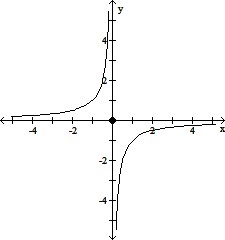Find the center, foci, and vertices of the ellipse. +
+  = 1
= 1
A. center at (0, 0)
foci at (0, -  ) and (0,
) and (0,  )
)
vertices at (0, -4), (0, 4)
B. center at (0, 0)
foci at (0, -4) and (0, 4)
vertices at (0, -16), (0, 16)
C. center at (0, 0)
foci at (0, 4) and (3, 0)
vertices at (0, 16), (9, 0)
D. center at (0, 0)
foci at (-  , 0) and (
, 0) and ( , 0)
, 0)
vertices at (-4, 0), (4, 0)
Answer: A
You might also like to view...
Find d2y/dx2 without eliminating the parameter.x =  , y =
, y =  , t > 0
, t > 0
A. - 
B. - 
C. - 
D. 
The figure shows the graph of a function. At the given value of x, does the function appear to be differentiable, continuous but not differentiable, or neither continuous nor differentiable?x = 0
A. Differentiable B. Continuous but not differentiable C. Neither continuous nor differentiable
Find the coordinates of the vertex and the intercepts of the quadratic function. When necessary, approximate the x-intercepts to the nearest tenth.f(x) = x2 - 10x - 11
A. V(5, -6); I(0, 11); (-11, 0); (11, 0) B. V(5, 6); I(0, 11; (1, 0); (-11, 0) C. V(-5, -36); I(0, -11); no x-intercepts D. V(5, -36); I(0, -11); (11, 0); (-1, 0)
Factor when possible.16a2b - 24ab - 40b
A. 8(2a + 5)(a - 1) B. 8b(2a - 5)(a + 1) C. 8(2a - 5)(a - 1) D. Prime